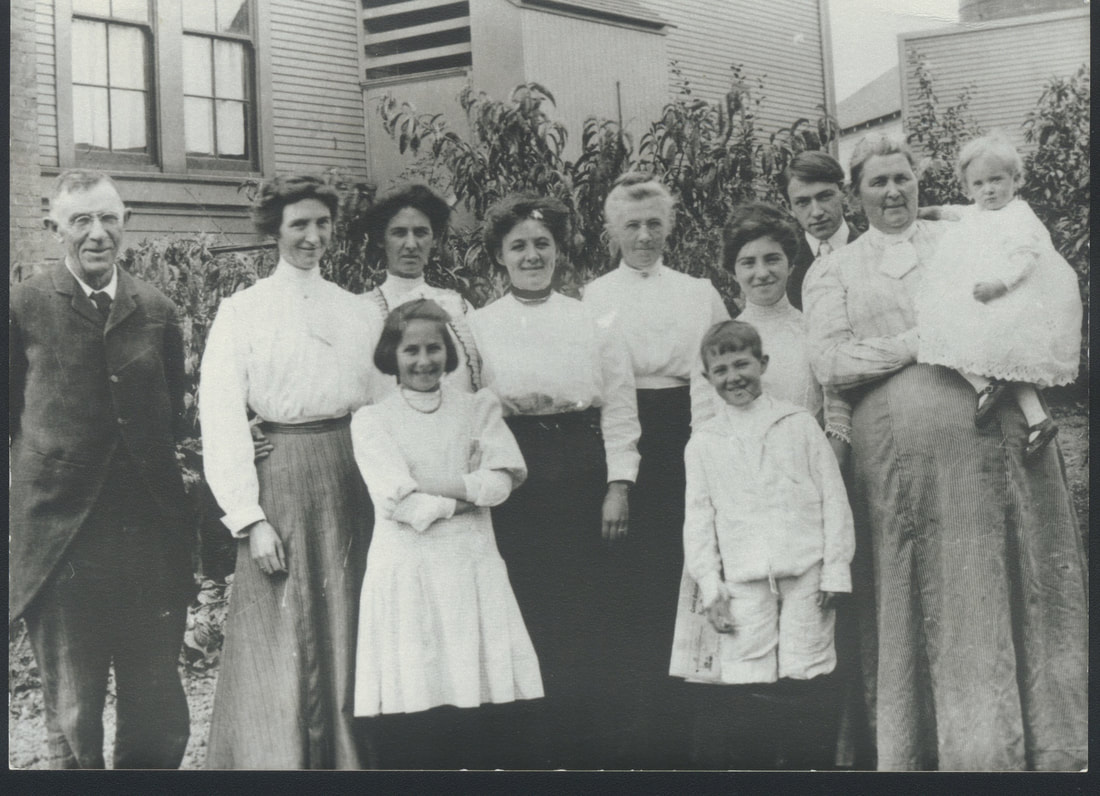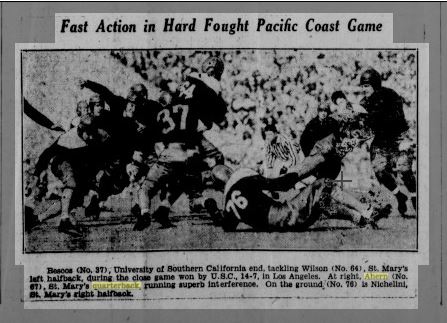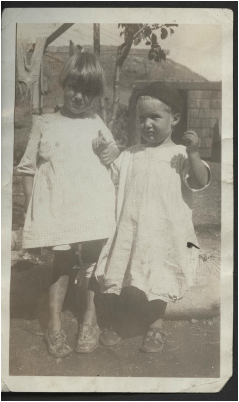|
It just can’t be said enough. Make friends with an archivist. The archivists I know are a special breed – history geeks with a penchant for organizing things and a yen to ferret out obscure and unseen treasures. They have so many resources at their disposal, and their job is to share!
I am writing a family sketch on my great-grandparents, Tom and Mary (Ahern) Bradley for my ProGen study course. The Bradley’s settled in Tiburon, California just as Tom’s employer, the California Northwestern Railroad (later the Northwestern Pacific), moved its terminus there around 1890. Their children and grandchildren grew up in Tiburon. The Bradley family had many connections with this small town on San Francisco Bay. I knew the Belvedere-Tiburon Landmark’s Society had some materials in their archive that my father and some of his siblings had donated, so I checked their catalog online and found a few items pertinent to my research, including a couple of oral histories. I reached out to the archivist, and boy, did I ever get lucky! Dave Gotz emailed some documents and photographs including a transcript of an oral history interview with my great-aunt Miriam “Brownie” Bradley. He’s put a few more things in the mail to me. He’s answering questions that continue to pop into my mind, and now that he knows I exist, he’s even sending me cool materials from the Society’s collection – pictures and newspaper clippings that I didn’t even know existed. But he did. Because he’s an archivist! The best treasure that arrived yesterday was a link to a video file of an oral history interview with my aunts Mary King and Sr. Bertha Kircher, recorded in October 1994. Mary died in 1996 and Bertha in 1999 but for half an hour yesterday I had these two dear women visiting with me in my living room telling me stories of Tiburon a century ago. Seeing them as I so fondly remember them, hearing their voices and unique ways of talking brought back a flood of my own childhood memories. Make friends with an archivist. They’re waiting with a treasure for you!
0 Comments
For Christmas of 1999, I sent my father a tape recorder and a list of questions. (Was this a gift for him or for me? I’ll let you be the judge of that.) But over the next few months and years, Dad answered the questions and I transcribed his words. I’m periodically posting some of his thoughts.
This section has to do with when the family got a radio. Dad talks about listening to football on the radio, and tracking the game. As someone who grew up in the TV generation, I appreciate the resourcefulness of radio sports fans. “We got a radio ourselves. We had a radio in the living room and we began to listen to things. Football, of course, was important. There were no professional teams. They did not come until 1945, after the war. But we did have colleges. Cal played Stanford. USF played St. Mary’s. St. Mary’s and Santa Clara were always a big deal. And they played on Saturdays and on Sundays. “And we would listen to our radio and put out a chart on the floor of the lined football field. 10 yards., and keep a little button and watch the ball go up and down the field, depending on whether St. Mary’s had made some yards or didn’t make some yards. “Football rules were different in those days, too. There were no center stripes for putting the ball in play. If you… wherever you were tackled, that’s where you put it. If you were tackled three yards from the sidelines, you’d start the next play three yards from the sidelines. If you ran out of bounds, you started the play one yard inbounds. So that sometimes the center was on the end and all the rest of the line was sticking over toward the center of the field. Most of those games were played 6-0, 6-7, or 13-6. You never heard of a game going over 20 points.” Tom Kircher, recorded sometime in 2000. I selected this particular section for a couple of reasons. I presented a session at the Northwest Genealogy Conference last week, “Telling Their Story When They Left No Stories.” One of the points I make is to think about everything in your life – work, clothing, entertainment, sports, religion, politics and more. If you do it or think about it, your ancestors probably did, too. As fall approaches teams both professional and amateur are gearing up for a new season on the gridiron. This memory from my dad speaks to one aspect of his life. Did your ancestors have any interaction with athletics, either as a player or fan? I’m on a research road trip. My husband found the recordings of my dad on his computer and burned some of them to CD for us to listen to in the car. Dad passed away eight years ago, but it sure is a treat to get to hear him tell me a story in his own voice. And I so love my husband for wanting to listen, too. As a bit of an aside, when Dad talks about football in this piece, he mentions St. Mary’s a couple of times. I wish I had followed up with Dad about why St. Mary’s seemed particularly notable. It wasn’t his alma mater. But it may have been his family particularly followed St. Mary’s because his mother’s cousin, Jim “Sid” Ahern, played for the Gaels. I can’t help but wonder if the game against USC was one Dad had listened to and tracked with his grid and button. Go Gaels! 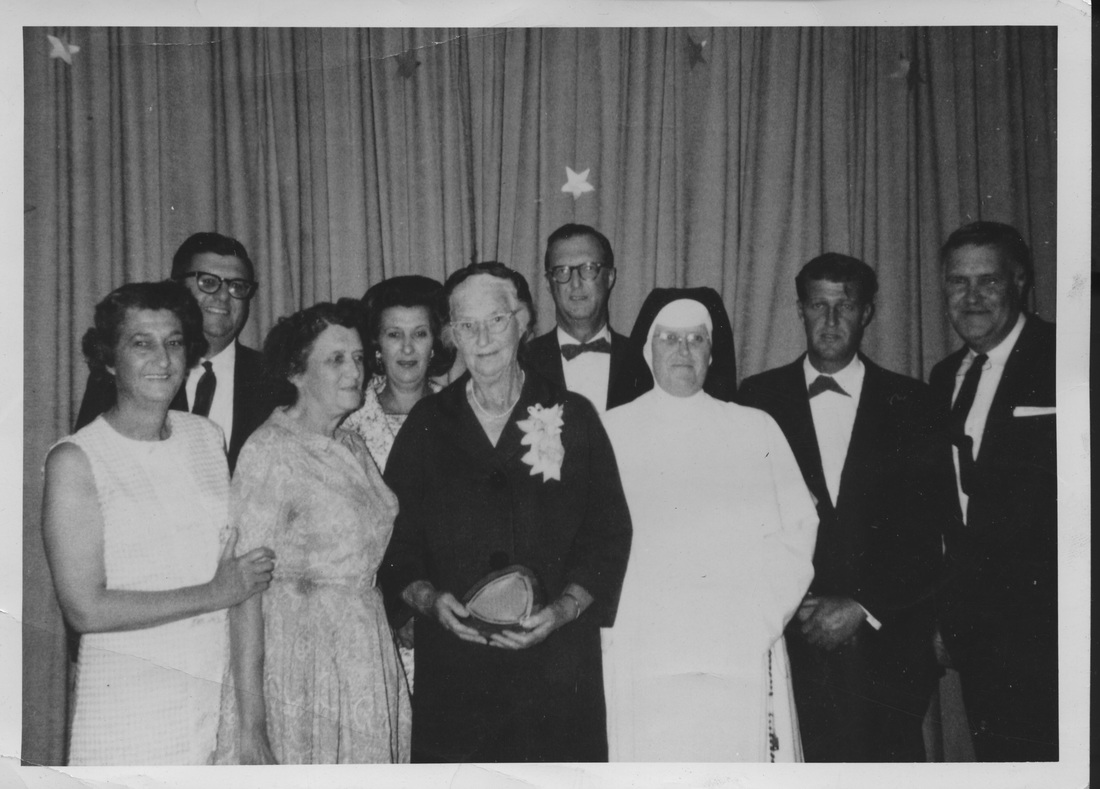 Agnes Bradley Kircher, surrounded by her children, when she was awarded Marin County Senior Citizen of the Year - Barbara, John, Mary, Kathryn, Agnes, Tom, Bertha, Phil and Charlie Agnes Bradley Kircher, surrounded by her children, when she was awarded Marin County Senior Citizen of the Year - Barbara, John, Mary, Kathryn, Agnes, Tom, Bertha, Phil and Charlie I read Randy Seaver’s Genea-Musings blog from March 23, 2016[i] in which he wrote about his grandfather. Randy doesn’t have a terribly positive impression of this ancestor, but his blog post got me thinking about why we might like some ancestors more than others. Do I have ancestors I don't "like"? Would I like them more or less if I knew more or less about them? Were some of them creeps but those qualities don't show up in the records? Or did one of them do one bad thing, and that's the only record I’ve found, so I have a bad impression, but in reality the rest of their life was good? Or were some of them great in public, in the records I do see, but horrid people behind closed doors? While I ponder the greater implications of those questions on my research, for today’s Sunday Stories I’d like to write about one ancestor I do have a very high opinion of, and I’m pretty sure most everyone who knew her. or who knew of her, would agree. Mary Agnes Bradley was born “at the foot of the Wildcat”[ii] near Petaluma, California in 1888,[iii] the middle child in a family of seven surviving children, with a few other siblings lost fairly young.[iv] When she was three, her family relocated to Tiburon when the railroad which employed her father moved its headquarters there. Agnes spent the rest of her life in the town on the shore of San Francisco Bay. She married Charles Kircher in 1909[v] and they raised their eight children across the street from the bustling railroad yards, in a three-story house with a view straight out the Golden Gate. I think her strong Catholic faith was a legacy from her parents, and she lived that faith through good works her entire life. To share just a few of her endeavors… Agnes was a founding member of the board of the Tiburon Sanitary District, serving as secretary from 1926 to 1958, and later as its president.[vi] She and Charlie were instrumental in getting one of the first sewage treatment plants on San Francisco Bay constructed in Tiburon, knocking on every door and button-holing the citizens of Tiburon to vote for the project. Her family fondly referred to it as “Ma’s Sewer Plant.” We’d pass by it every time we went to visit her when I was a little girl. (In fact when my dad first brought my mother home to meet his folks, he of course had to point out Ma’s Sewer Plant. My mom wondered just what kind of a family this was whose mother had her own sewer plant!) Agnes was an election judge at the polls in Tiburon.[vii] She was involved with the Tiburon Mothers’ Club.[viii] She was a member of the Young Ladies Institute, a Catholic women’s service organization. She was a manager of the Village Salvage Shop in Tiburon, a joint venture between the local Catholic, Presbyterian and Episcopal churches and the PTA. She served on the juvenile probation committee and the citizens’ advisory committee for planning. She was a charter member of the Tiburon Peninsula Club and the Belevedere-Tiburon Landmarks Society.[ix] For these and countless other efforts, she was named Marin County Senior Citizen of the Year in 1966.[x] Agnes’ influence continued on to her children and grandchildren. My dad drove people to the Handicapables Luncheons for years in Marin and later delivered Meals on Wheels in Benicia for 20 years. My aunt Mary volunteered at the Gift Shop at Mission San Rafael Arcangel. My sister, Tori, is a regular volunteer with the St. Vincent de Paul Society. I’ve had the chance to be on the board of the Catholic Seafarers’ Center and the Association for Catholic Childhood in Seattle. In fact when ACC was looking for a volunteer to take over as treasurer, I have no doubt that Grandma Kircher, seated on a perch in heaven next next to a choir of angels, had somehow tied an invisible string to my hand and yanked that sucker right up. But even with all those good works in Agnes’ life, I think the thing that inspires me most was something my dad told me she used to say, “When you come to the “but” in the sentence, stop. ‘She’s a nice girl, but….?’ No. If she’s a nice girl, she’s a nice girl. Period. You don’t need to go beyond the ‘but’.” Words to live by. I am honored to be the granddaughter of Agnes Bradley Kircher, and I strive to live up to her example. [i] http://www.geneamusings.com/2016/03/100-years-ago-today-my-great.html [ii] Personal recollection of Thomas B Kircher to author [iii] Church records of St. Vincent de Paul Catholic Church, Petaluma, Sonoma, California [iv] Household of Patrick Bradley, Year: 1900; Census Place: Belvedere, Marin, California; Roll: 93; Page: 11A; Enumeration District: 0061; FHL microfilm: 1240093; Household of Patrick Bradley, Year: 1910; Census Place: Sausalito, Marin, California; Roll: T624_88; Page: 9B; Enumeration District: 0050; FHL microfilm: 1374101 [v] Marin Tocsin, 9 January 1909, page 1, “Miss Agnes Bradley and Charles A. Kircher Wed” [vi] Ebb Tide, 1 June 1966 [vii] Marin Journal, Volume 52, Number 33, 13 August 1914 [viii] Sausalito News, Number 5, 29 January 1932 [ix] Marin Independent Journal, 10 May 1966 [x] Ebb Tide, 1 June 1966 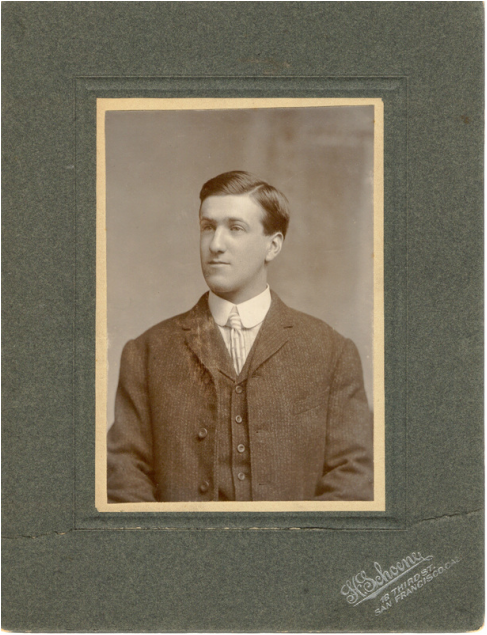 In 1999, stuck for thinking of a Christmas present for my father, I sent him a letter, a tape recorder and some blank tapes. The letter contained, among other things, a list of questions I wanted to know about his childhood, family, education and more. (Who exactly was this present for?? I was putting him to work, filling cassettes with stories he could send back to me!) But Dad filled several tapes with stories and I transcribed them. From time to time, I’ll share some of these stories. My siblings have the book I transcribed of all these stories, but perhaps my cousins and others would enjoy reading them. It seems appropriate to share this story today, 6 March. My grandfather, Charles Arthur Kircher, passed away on 8 March 1952. In Tom Kircher’s words… “In Tiburon, Bobby Williamson[1] always had a slogan for anything – “a stitch in time saves nine,” “a job begun is half-way done” and all that kind of stuff so now we’re into the business of a job begun. It’s hard to figure out just exactly where to start, but one of the things about the questions you asked about my childhood and growing up and stuff, it has to start in, say, three different places – one of them, I think, is in Webster, New York, and you have to kind of understand what kind of a guy Charlie Kircher[2] was. He was a farm boy. His father was a farmer and they had orchards and they did their chores before going to school and I think he was probably one of the few guys at his age that was able to finish high school and he was bright enough to do that. He had one brother and two sisters[3] and I think they were smart enough, too, but Daddy got out of high school in Webster, New York in 1898[4], I think, and went on to Dartmouth and graduated from there in 1902. He was able, because of his grades to obtain a scholarship to Dartmouth. I don’t know whether it was a full scholarship or a partial. Among other things, he had a job to do on the campus, and that was to ring the bell for chapel in the morning to wake everybody else up to go to chapel, and he had to do the ringing. He then lived. He then lived off campus, I think, in a house that was a…that had a woman by the name of Emma Hahn, and she was his “other mother” and he spoke of what a lovely lady she was. And there are pictures in the album of Emma Hahn.[5] I’m sure as we continue on from time to time, I’ll b referring to what kind of a guy Daddy was, and how he did different things. I know that in later years when I spoke with Mary Frances,[6] she sure had a good memory of the quirkiness and the clever wit and the twinkly eyes that Daddy had on certain occasions. But being a farm boy, you had to be everybody, you had to do every single thing. You didn’t call the plumber. You didn’t call the electrician. As a matter of fact, when you were a farm boy, there was no electrician, you were still living with oil lamps, and he didn’t learn electricity until he came to San Francisco, to Marin County, probably, and became a homeowner and had to learn electricity. But when he was doing those things, he did it in the way a farm person would. You’d do it yourself, get your friends to help you, or your parents and get it done. So that’s the kind of guy he was. He was, as you know, a pretty strict Methodist, that’s the way he was brought up. Said his prayers and sang the hymns. Years later he knew all the words to every hymn that I ever heard – most of them I didn’t hear either.” I will share more of my father’s stories about his family in the coming months. [1] I believe this to be Robert L. Williamson, son of Richard and Adna Williamson. The Williamson family was enumerated two households after the Kircher family in the 1930 US Federal census at Year: 1930; Census Place: Sausalito, Marin, California; Roll: 177; Page: 4A; Enumeration District: 0044; Image: 352.0; FHL microfilm: 2339912 [2] Charlie Kircher was my father’s father, Charles Arthur Kircher, born in Webster, Monroe, New York in 1879 to Charles Conrad Kircher and Frances Abelone Springer. [3] Irving Henry Kircher (1882-1974), Helen Louisa Kircher (1888-1970) and Stella Mae Kircher (1889-1958) [4] I have Charlie’s diplomas and he graduated in 1897 from Webster Union High School, and from Dartmouth in 1902 [5] Out of curiosity on 27 February 2016 I looked on the 1900 census for an Emma Hahn in Hanover, Grafton, New Hampshire. I could not find any Emma Hahn. I could not find anyone by the name of Hahn that seemed to fit, living in Hanover. I did find an Emma Barnes who was a 42 year old widow in 1900 and ran a boarding house (Year: 1900; Census Place: Hanover, Grafton, New Hampshire; Roll: 946; Page: 17B; Enumeration District: 0060; FHL microfilm: 1240946) and also ran a boarding house in 1910 (Year: 1910; Census Place: Hanover, Grafton, New Hampshire; Roll: T624_861; Page: 5A; Enumeration District: 0087; FHL microfilm: 1374874) so perhaps my father was mistaken in his memory that her name was Emma Hahn. [6] Mary Frances Kircher was my father’s oldest sister, born in 1909. 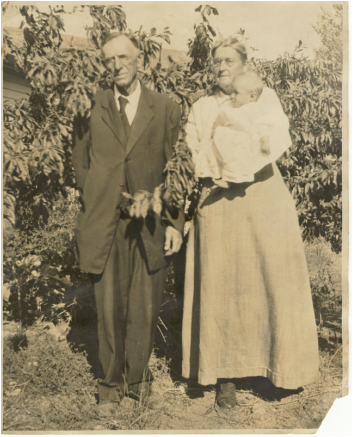 Patrick Thomas and Mary Agnes Bradley, circa 1910 Patrick Thomas and Mary Agnes Bradley, circa 1910 My father passed away in 2008. I think Dad enjoyed my exploration into family history. I’m pretty sure he thought it was a little weird, but I think he enjoyed it, nonetheless. And I know that my discovery in 2006, of events which occurred in 1900 and 1901, finally helped him to understand the reasons his grandmother’s behavior shocked him so in 1929. After my uncle Charlie graduated from eighth grade, his parents, Charlie and Agnes, took the train across the country from Tiburon, California to Webster, New York to bring their son to meet his grandfather, another Charles Kircher. They left their oldest daughter, nineteen-year-old Mary, to take care of her younger siblings remaining at home – Bertha, Barbara, Kathryn, Tom, (my dad), and John. Agnes’ parents lived just down the road, and would be there to help out if needed. One day, Mary said to her charges, “Don’t pick any blackberries. I’ll need them to make a circus cake.” Kathryn and Tom went into the yard and Tom immediately popped a blackberry in his mouth. Nine-year-old tattle-tale Kathryn said, “I’m gonna te-ell,” stuck her tongue out, and ran into the house. Fearing the wrath of his sister, Tom’s immediate reaction was to hide, somewhere, anywhere, and stay there until the storm blew over. The basement looked like a good place. With Kathryn’s news, Mary looked for Tom but couldn’t find him. She searched high and low, but no Tom. Hours passed, and eventually she had to fess up to Grandma that she’s lost one of her charges and enlist her aid. The Kircher home was a block from the edge of San Francisco Bay, and I imagine that when Grandma Bradley called out for her grandson, the foremost thought in her mind was of her niece Agnes Jane, drowned in the waters of Tiburon nearly thirty years earlier, and of the way that loss destroyed the life of her sister-in-law, Sarah. How would her daughter handle the guilt of having left her children while she went away on a pleasure trip? What regrets would haunt her granddaughter who let her little brother drown in those very same waters? These fears must have colored her voice as she call into the basement, “Tom, Tom, are you there? Come out.” But seven-year-old Tom didn’t come out. Not the next time she came to the door. And not the next. Eventually, Charlie Orbell, the boarder on his way to his room in the Kircher basement, saw Tom hiding behind a pile of scrap wood and said, “You better get upstairs. They’re looking for you.” Finally, Tom showed his face. I’m sure Grandma Bradley hugged the breath out of him when he appeared at last. Dad recalled that for weeks after, whenever she saw him, she’d shake her finger and admonish, “I’m gonna get you. I’m gonna get you. Not because you hid, but because you didn’t come out when I called.” When Dad was seven years old, he’d never heard of his great-aunt, Sarah, nor his mother’s wee cousin, Agnes Jane. He had no notion why his simple act of hiding could scare his grandmother so. But in 2006, when I shared the stories of the little child drowned in the lagoon and her mother’s tragic death a year later, Dad finally understood why his Grandma Bradley threatened to “get” him. And as Judy G. Russell told those of us lucky enough to hear her at the Salt Lake Institute of Genealogy, our charge is to tell the stories of those youngest ones who didn’t survive. In telling their stories we help others make sense of their history. 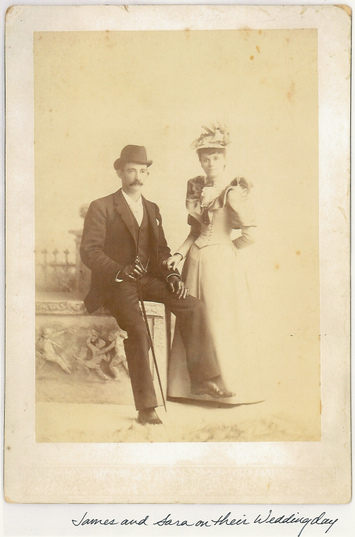 Sarah Davidson Ahern suffered the most devastating experience known to a mother, the loss of a precious child, Agnes Jane, on February 15, 1900. I don’t know what that feels like, and I can’t know how that loss affected Sarah, her husband, Jimmy, or her other two daughters, Bessie and Irene. But I do know that the loss must have haunted Sarah for the remainder of her short life. Agnes Jane wandered away from home and drowned in the lagoon in back of her house. Almost exactly a year later, in February of 1901, Sarah became pregnant. But laughter from this new life would never grace the Ahern home. In the evening on May 9, 1901, Dr. Florence Scott of Belvedere was called to the Ahern home to find Sarah suffering in bed. Sarah indicated she had given birth to a fetus about six o’clock. While Dr. Scott attended to Sarah and telephoned for another more experienced physician from San Francisco to assist, Sarah told her that she had taken some pills on and off for the last two months, but would not say who had given them. Jimmy returned from work about 10 p.m., the doctors left in the early hours of the morning, and Jimmy and neighbor, Katharine Sanger, attended Sarah until six a.m. when she took a turn for the worse. Jimmy left to telephone the doctors, and when he returned he found Sarah dying.[i] Later that day, on Sarah’s bureau he discovered a box and some business cards of Mrs. J. A. Achard, a San Francisco midwife.[ii] Five people testified at the coroner’s inquest held in the Ahern home that day, including Dr. Wickman, who declared that he examined Sarah’s remains and finding a perforation in the uterus, determined that she was pregnant for about three months, and that she aborted and died of septicemia. Julia Achard, also known as Julia Shiland (the name of her fourth husband), denied having touched Sarah or giving her any medicine, stating that Sarah had invited her over for some “chow-chow and chili sauce.” In the end the jury ruled that Sarah came to her death by blood poisoning following miscarriage from causes unknown.[iii] Did Sarah want the child but allow external doubts about her ability to be a good mother change her decision? Did Jimmy want another child from this emotionally fragile woman who couldn’t go through with a pregnancy? Whatever the reasons, I’m confident that if the winsome Agnes Jane hadn’t drowned a year earlier, Sarah’s husband and daughters would not have faced the second horrific loss, that of their wife and mother. My father never knew Sarah. He remembered Uncle Jimmy and his second wife, Aunt Laura. But when my genealogy research led me to the events that hit this family in 1900 and 1901, my father finally understood that day in the summer of 1929 when his loving Grandma Bradley shook her finger at him and admonished the seven-year-old “I’m gonna get you.” More next week.,, [i] Testimony of Coroner’s inquest held May 10,1901 at Tiburon Marin Co upon the remains of Mrs. Sarah Elizabeth Ahern [ii] The Marin Journal, 16 May 1901 [iii] Testimony of Coroner’s inquest held May 10,1901 at Tiburon Marin Co upon the remains of Mrs. Sarah Elizabeth Ahern Inspired by Judy G Russell’s excellent keynote, “Suffer the Little Children,” at the SLIG banquet, I’m inspired to write my first genealogy blog post about just such a story.
I’m sure that when Jimmy Ahern boarded the ferry from Tiburon to San Francisco on the morning of February 15, 1900 he had little idea of how much more tragedy would strike before the day was done. Jimmy and his sister, my great-grandmother, Mary Bradley, were embarking on one of the most sorrowful of tasks, traveling to the city to help their sister-in-law, Becky, plan the funeral of their brother, Henry, who had died the previous day.[i] While he was away, Jimmy’s wife, Sarah, attended to her household tasks, perhaps laundering the clothes the family would wear the next day or preparing food for the mourners and visitors who would undoubtedly gather. As she worked, distracted by her grief, the youngest of her three daughters, fifteen-month-old Agnes Jane, named after both of her grandmothers, wandered away from the family home. How long until Sarah noticed the child’s absence is unclear, but once she did, she raised the alarm in the small railroad town, and neighbors and colleagues of her husband, an engineer with the California Northwestern, began to scour the town for the toddler. Nearly an hour later, Fred Curtis discovered the lifeless body of the little girl, lying face-down in the shallow tidal lagoon behind the Ahern home.[ii] Yet more tragedy would befall Jimmy later that evening. As Sarah and a neighbor toiled upstairs in the house preparing Agnes Jane for burial in the morning, Jimmy, Mary Bradley and Felix Murphy, one of the pall bearers who would carry the little white coffin the next day, gathered to visit in the quiet of the yard. The neighbor’s child was there, too, and when she reached up to pet Jimmy’s bird dog, the animal snapped at the child, lacerating the face. After losing his brother and daughter within a day, Jimmy had to put down the dog.[iii] The loss of Agnes Jane had grave implications for Jimmy’s family the following spring, and sent ripples of grief that would touch his sister’s family a generation later. More next week…. [i] Petaluma Argus, 16 February 1900, page 1 [ii] Testimony of G. F. Lewis at the Coroner’s Inquest held at Tiburon, Marin County, California, February 15, 1900 upon the body of Little Agnes Jane Ahern who was found drowned in the lagoon [iii] Petaluma Daily Courier, 16 February 1900 |
AuthorMary Kircher Roddy is a genealogist, writer and lecturer, always looking for the story. Her blog is a combination of the stories she has found and the tools she used to find them. Archives
April 2021
Categories
All
|
